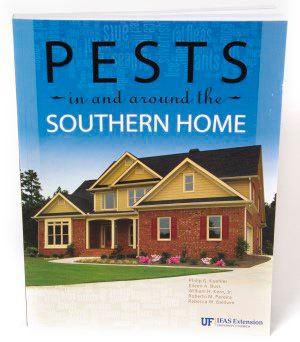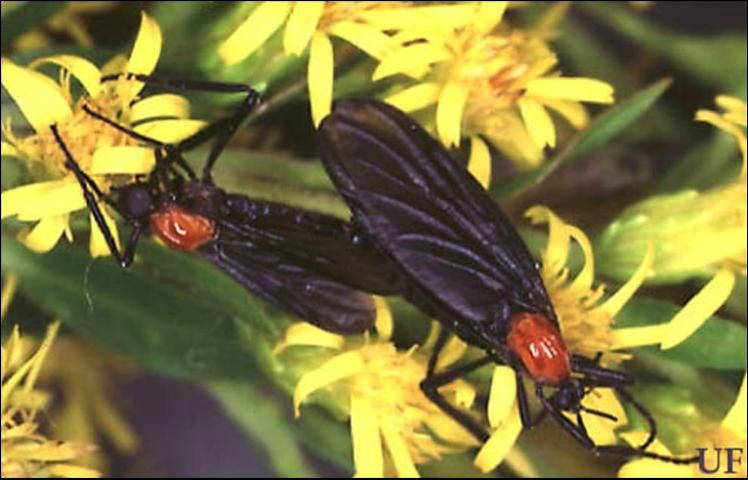Lovebugs in Florida

Credits: UF/IFAS
The "lovebug" (Figure 1) is a fly in the family Bibionidae that is easily identified by its black, slender body and red thorax. These small flies, also known as March flies, are closely related to mosquitoes and gnats. The males are about 1/4 inch (6 mm) in length, while females are 1/3 inch (8 mm) in length. There are two known species of lovebugs in the United States. Originally it was believed that the lovebugs were invasive, having come from outside the United States, but that is not the case.

Credits: UF/IFAS
Both species of Plecia in the United States today, P. americana and P. nearctica, are native to the United States. Plecia nearctica was described from Texas in 1940. Both species are found in states around the Gulf of Mexico. Plecia americana is all the way to North Carolina and has a more northern distribution, while P. nearctica is known all the way to Costa Rica, having a more southern distribution.
Little is known of the P. americana species, but P. nearctica has two key outbreaks in population a year: once during April–May and the next in August–September. They are often found near or by highways and are a nuisance and hindrance to drivers, and their body contents may damage car paint. However, there are some beneficial aspects to this species as it helps change decaying vegetation into hummus, or fresh new nutritious soil. Adult lovebugs like to seek pollen and nectar, therefore they may be important in pollination.
Life Cycle
Female lovebugs lay 100 to 350 eggs that are deposited underneath debris and decaying vegetation. After about 20 days, the larvae hatch and feed on the decaying plant vegetation. The larvae act as a decomposer in the natural habitat by converting the plant material into nutrients that can be used by the growing plants. Once the larvae mature and have stopped feeding on the decomposing vegetation, they pupate. In warmer climates, such as Florida, the generation during the summer is significantly shorter than the winter generation because the rate at which the larvae pupate increases significantly with an increase in temperature. The pupal stage generally lasts about seven to nine days.
Adult lovebugs are nonthreatening to humans because they do not bite or sting. They primarily feed on nectar from various plants, particularly sweet clover, goldenrod, and Brazilian pepper. Under laboratory conditions, male lovebugs live for about 92 hours, whereas females live up to 72 hours. In nature, the adults live just long enough to mate, feed, disperse and deposit a batch of eggs — about three to four days. Lovebug flights are usually restricted to daylight hours and temperatures above 68°F or 20°C. At night lovebugs rest on low-growing vegetation.
Mating
In the lovebug, copulation begins with males flying and swarming above females, who remain on or close to the ground. The swarm is most dense from one foot to about five feet off the ground, but the swarm can be as high as 20 feet (6 meters) above the ground and can contain up to 40-plus males. Larger males often dominate the bottom of the swarm in competition to get a fit mate. The males prefer larger, heavier females because they provide better odds of reproducing and mating.
Males hover over the females by orienting themselves with the wind in order to ease flight. As the females emerge from the vegetation, males immediately swoop down and grasp a female. At times, males will grasp a female that is already mating with a male in an attempt to disrupt mating. As many as 10 males have been observed holding onto a female, each attempting to copulate. After finding a match, the pair will come to a rest on the vegetation below and finish their mating process, during which the male faces the opposite direction of the female.
Lovebugs Hinder Motorists
Lovebugs are a considerable nuisance to motorists. They congregate in unbelievable numbers along highways, and the insects spatter on the windshields and grills of moving vehicles. Windshields become covered with the fatty remains, and vision is obstructed. During flights, the flies clog radiator fins, causing cars to overheat. They also get into refrigeration equipment on trucks, causing them to malfunction. The fatty tissue will cause pitting of the car's finish if it is not removed within a few days. Flies enter cars and sometimes are crushed by drivers and passengers, causing stains on clothing. They are also a considerable nuisance to fresh paint. The flies enter houses under construction in such numbers that carpenters refuse to work. Beekeepers complain because worker bees do not visit flowers that have been infested with the flies. A number of insecticides have been evaluated for effectiveness in controlling lovebug larvae and adults. Most of them kill lovebugs but are impractical because high populations of the insects occur over vast areas of the state. A vacuum cleaner can be used to remove adults from confined areas, such as in buildings and vehicles.
Predators Reduce Lovebug Flights
During the past several years, both the April–May and August–September lovebug flights have been substantially reduced in north central Florida. This reduction in the population is partly attributed to predators. Larvae aggregate in extremely high numbers in pastures and other grassy habitats. This makes them vulnerable to foraging birds. Lovebug larvae have been found in the gizzards of robins and quail. Although examinations of the stomach contents of armadillos have been negative, observations suggest that they, too, may be excellent predators of the larvae.
Some natural enemies of lovebugs are fungi. Although more time and research are needed, nine different species of fungi are known to affect lovebug larvae. However, available data indicate that only the fungus Beauveria bassiana causes significant mortality levels (27 to 33%) in adults and immatures. Laboratory studies using invertebrate predators found in lovebug-infested pastures indicated that these predators included earwigs, two species of beetle larvae, and a centipede.
There are several things that can be done to lessen the problem facing motorists. By traveling at night motorists can avoid the insects; lovebugs reach peak activity at 10 AM and stop flying at dusk. Traveling at slower speeds will reduce the number of bugs that will be spattered. A large screen placed in the front of the grill will keep the radiator fins from clogging, and will protect the finish on the front of the car. If a large screen is not used in front of the grill, a small screen can be placed behind the grill in front of the radiator.
Spattered bugs should be washed off the car as soon as possible. Lovebugs are more easily removed, and the chance of damaging the car's finish is lessened, if the car has been waxed recently. When the remains are left on an unwaxed car for several days, the finish will often be permanently damaged. Soaking splattered lovebugs for several minutes with water aids in their removal. When lovebugs are numerous, motorists may choose to spread a light film of baby oil over the front of the hood, above the windshield, and on the grill and bumper. This practice will make lovebug removal a simpler task.




